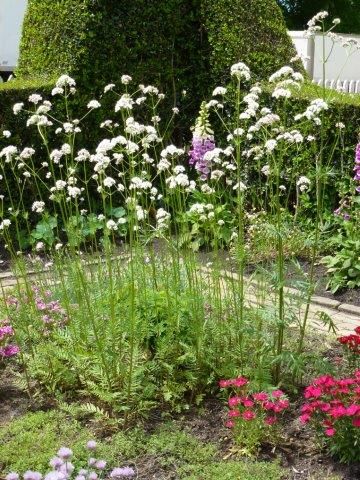
On my last blog, I highlighted the Colonial Gardens in Williamsburg, having to limit myself to just 12 images. Here are 12 more with details on the conference, farmers’ market and two great books as well as a few more herbs. Gathering at herbal conferences allows us to commune with nature in gardens; share thoughts and ideas, books, products and art work; as well as hang out with other like-minded people. This is not only fun–it is inspiring and thought-provoking, energizing and rewarding.
This last conference, in particular, I found myself saying yes, I am going to do some of these things and incorporate them into my life. All of the programs were stimulating and speakers were knowledgeable and entertaining. (To read more details about programs and presenters got to: https://www.herbsociety.org/events/conference-15.html) Topics ranged from historic gardens, colonial uses of plants to present day, notable natives and promising plants to nature in our own backyards, and creating Italian liqueurs! Kudos to HSA staff for their hard work and dedication on putting on our Educational Conference.
Two of the programs, which I really wanted to attend, follow with their descriptions.
Douglas Tallamy, who is the author of the informative and inspirational book, Bringing Nature Home, explained the importance of biodiversity and the role of native plants in helping us sustain it. His photographs of plants and trees, insects and birds are phenomenal. The importance of choices made by gardeners was emphasized, along with a passionate plea for the inclusion of native plants in our gardens. It caused me to rethink what I am planting in my own garden–what to keep and what to get rid of. (For more info about Doug and what he does go to: https://www.bringingnaturehome.net/)
I tried to purchase the following book on the Aboca Web site over a year ago, however it was only available in Italian–so I was delighted to meet Renato and Janette and acquire their book. Italian Liqueurs – History and Art of a Creation by Renato Vicario articulates that the creation of a fine liqueur mirrors the art of a fine painting. His lecture explored how traditions developed and provided practical knowledge about how to create homemade liqueurs. It also included the medicinal and cultural importance of making liqueurs through the centuries.
I have been making liqueurs and cordials for over 30 years, so I was looking forward in particular to new and traditional formulas–and I am not disappointed. Italian Liqueurs – History and Art of a Creation is a beautiful book, well written and researched, full of information from history and taste to techniques for creating your own, a pharmaceutical glossary, thorough botancial dictionary, and is brimming with mouth-watering recipes. I think I counted over 140 recipes using herbs, spices, fruit, nuts and vegetables. Absolutely inspiring, I can’t wait to start experimenting with some of the recipes, which are easy to follow and not difficult. It will be challenging to decide what to make first, however thinking seasonally, I find Nettle Liqueur an intriguing place to start. The hardest part will be to wait until they are ready to drink! Part of the delight of this book is the visual illustrations. The artwork was chosen and captioned by Janette Wesley and oh my what an aesthetic she has! She has selected a breathtaking art collection that resounded with me.
I enjoyed visiting with these lovely artists and if you want to create your own liqueurs, this book is the one to choose! Renato and Janette spend their time between Italy and South Carolina. In the U.S., their book is available from www.fiction-addiction.com. Their Web site is https://www.salutellc.com/ where you can read about them and their products and salivate over the descriptions and labels of some of their soon-to-be released liqueurs (summer 2015) in the U.S.A.
Besides all of the insightful presentations, there were herbal workshops and one presented by Pat Kenny (this year’s award winner for the Helen de Conway Medal of Honor–yay PK!) on an appropriate historic subject, pomanders. It was a relaxing and fun workshop and smelled lovely of cloves and citrus and apples. My favorite of all the pomanders were the kumquats, which were just darling… though the banana pomander made me laugh pretty hard.
Well, I have to end here with the farmers’ market in Williamsburg, which is right there in the town square–on Saturday from 8:30 a.m. to 1 p.m.–no cars allowed, and the walkways were lined with colorful plantings of flowering annuals and perennials. It was a delicious and mouth-watering market with lots of friendly farmers and purveyors and I came away with more than I could carry in one trip to the car. Wherever you may go, support your local farmers and growers–buy local–eat seasonally!





























Comments
Log in or create an account to post a comment.
Sign up Log in